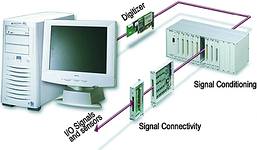

Engineers and scientists are frequently turning to computers as the foundation of their data logging systems. Traditionally, data logging applications have been implemented using turnkey ‘data loggers’ – standalone devices that record signals and either store them in internal memory or print them on paper. The data from these loggers typically must be transferred to a computer because most applications also require analysis, archiving, presentation, and data sharing.
Transferring the data is typically a manual, time-consuming process. Additionally, users must learn to operate two separate systems - the logger and the analysis and reporting software on the computer. While these standalone data loggers serve certain applications well, there are many situations where it is more productive and cost-effective to acquire and store the signals directly with a computer.
One of the primary reasons that computer-based systems are becoming a more attractive choice for data logging applications is the integration of the measurement system with the computer, combining two systems into one. Using the computer as the logging system avoids the step of transferring the data from the standalone logger to the computer, saving time. Modern software tools can automate the entire logging task, including the storage, analysis, presentation and data sharing. Additionally, computer-based logging systems can use a wide range of data acquisition and signal conditioning hardware. By choosing an approach that uses the computer as the data logging system, the user gets the advantages of an open, flexible architecture that can be expanded and modified as needs change.
What it takes to put together a computer-based data logging system: From a hardware perspective, there are three basic components that make up the logging system - the computer, the measurement hardware, and the sensors. The computer can be a standard desktop, a laptop, or a ruggedised industrial computer. The sensors, which convert physical parameters into electrical signals, consist of thermocouples, strain gauges, pressure transducers, flowmeters, accelerometers, and more. The measurement hardware is the component that turns the computer into a data logging system. Some key features to look for in measurement hardware are:
* Tightly integrated components that are designed to work together.
* Modular system that can be easily expanded or modified as requirements change.
* Hardware that has many options for sensor type, channel count, and connectivity.
* Detailed accuracy specifications and calibration procedures that allow users to verify the accuracy of the data that they record.
Measurement hardware can be further broken down into signal connectivity, signal conditioning, and digitiser. These pieces may be combined into a single unit for ease-of-use and simplicity, or they may be components that are chosen individually for maximum flexibility. Signal connectivity allows the sensors to be attached to the measurement system. The most basic connectivity is screw terminals, but other options include thermocouple jacks, BNC connectors, banana plugs, and LEMO connectors. Sensor types and channel density typically define the connectivity choice.
Signal conditioning performs a variety of functions including sensor excitation, filtering, amplification, isolation, multiplexing, and cold junction compensation. The type of conditioning required depends on the sensor type. For example, strain gauges require voltage excitation, bridge completion, filtering, and amplification. The digitiser converts the analog electrical signals into digital values and passes those values back to the computer. The digitiser can be a plug-in data acquisition (DAQ) board, or it can be integrated into a single package with the conditioning and connectivity.
A computer-based data logging system depends on software to give the user a productive, flexible solution. The measurement software must be designed to integrate seamlessly with the hardware. In addition to the basic task of acquiring data and logging it to disk, the software should provide tools to handle configuration of hardware, scaling of data from channels, and calibration of the system. The software should allow the user to complete their entire application - including data presentation, analysis, archiving, and sharing.
The two classes of measurement software that can be used for computer-based data logging systems are application development tools and configuration-based application packages. Configuration-based packages are ready-to-run software applications that interface with the user's measurement hardware to acquire and log data. These applications provide a user-friendly environment for configuring the logging task and getting up and running quickly. A good configuration-based data logging software package should provide:
p Intuitive user interface.
* Easy method for setting up logging parameters.
* Automatic data storage and archiving.
* Capability to export data.
* Alarming and trending tools.
A disadvantage of configuration-based applications is that, unless there is a method for customisation, the user is locked in to the functionality provided by the manufacturer.
The other software options for computer-based data logging are application development tools. These tools allow the user to build their own customised data-logging application that does exactly what is needed. Application development tools give users the abilities to modify their application as their needs change, integrate customised analysis and reporting capabilities with their logging application, and fully automate their data logging systems.
Computer-based data logging systems create many advantages for applications. Bringing the measurements to the computer gives the user an integrated system that combines the logging task with the storage, display, analysis, and data sharing. These improvements give users more productivity, increased flexibility, and enhanced capabilities.
For more information contact National Instruments South Africa, 011 805 8197, [email protected], www.ni.com

© Technews Publishing (Pty) Ltd | All Rights Reserved